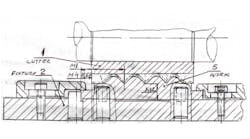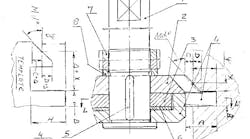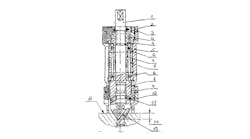Gear hobs (GH) used to produce spur and helical gears have trapezoidal profiles with different angles — 14.5 degrees, 20 degrees, 25 degrees — the same as profiles of standard basic racks. According to my hypothesis, these GH profiles can be converted to each other, and vice versa, if they have same circular pitch C (C=3.14159/P), or diametral pitch P (P = N/D) or module.
This concerns finishing and roughing GH. We can grind and relieve GH with trapezoidal profiles of teeth at 20 degree to receive 14.5-degree teeth, at 25 degree to receive 14.5-degree teeth, and 25 degree to receive 20-degree teeth. This means grinding teeth with bigger angle to receive teeth with smaller angles – group A. We also can grind vice versa, from 14.5 degrees for 20-degree teeth, from 14.5 degrees for 25-degree teeth, and from 20 degrees for 25-degree teeth. This means grinding teeth with smaller angles to receive teeth with bigger angle – group B. These two groups have 3×2 = 6 combinations of conversions by grinding and relieving.
Using conversion, GH users will benefit from the economies of scale (time, materials, energy, low cost) and have supply alternatives for emergency situations, because we make only the last technological operations of grinding and relieving, and do not make the large number first. Many GH (used and new) can be found in industrial companies, and this is a large source of reserves for producing essential GH (and starting good businesses.)
We have developed two methods for conversion, analytic and graphic, which check and correct each conversion. The analytic method includes mathematic formulas, algorithms, computer programs, and a table that shows the results of the method.
For group A, from P3 (approximately m = 8.5), sizes M for grinding outside diameter (with equal sizes of grinding inside diameter) starting from 0.072 in., it’s necessary to grind the angle; after P5, P6, M become smaller and smaller.
For group B (vice versa) M (starting from P3) more than 15.7%, then group A and after, P5, P6 becomes smaller.
The analytic method shows: (1) that the bigger P gear hobs have the smaller sizes of grinding M; (2) that brings to light rules of similarity and proportion for all M. It means that if we know M and P of the gear hobs we can calculate any corresponding M of any fixed P.
(3). As the differences between the angles becomes smaller, M is smaller too.
The graphic method controls the analytic method and shows a full picture of conversion and grinding for two groups, A and B, which are different.
For Group A we inscribe profile teeth drawing 14.5 degrees into profile teeth drawing 20 degree, so that their tops touch and the vertical axes are congruent.
For Group B (vice versa) we inscribe profile teeth drawing 20 degrees into profile teeth drawing 14.5 degrees, so that their sides touch. Each drawing has two or three teeth for a full picture when tracing or film paper in a scale of 20:1, or on the computer screen (CAD, Zoom). All teeth can be measured and inscribed on an optical comparator or calculated by standard formulas. You also can inscribe on the computer screen.
The composite drawing shows how much material will have to be drawn from the source teeth 20 degrees to impact the proper profile for forming teeth of 14.5 degrees, or vice versa.
We also offer conversion for milling cutters and cutting tools, with one profile to the other and vice versa.
For speedy decisions on the conversions we offer customers one formula with three coefficients for each group. After receiving proper GH it best to make test by hobbing samples before producing the gears.



